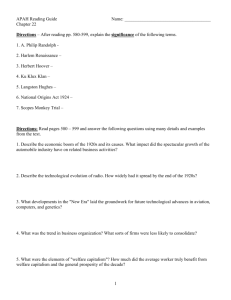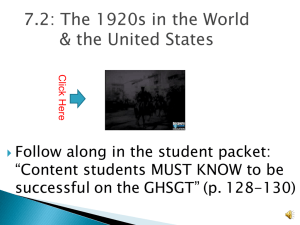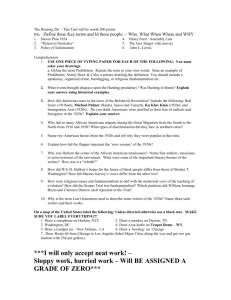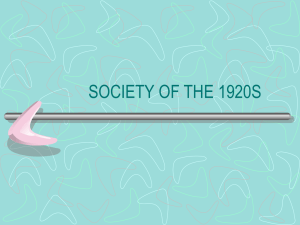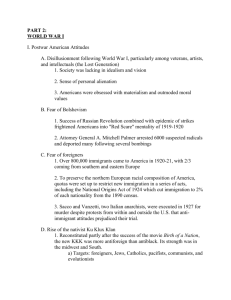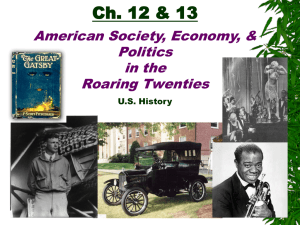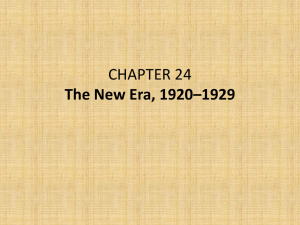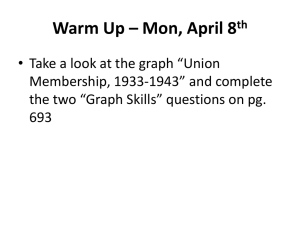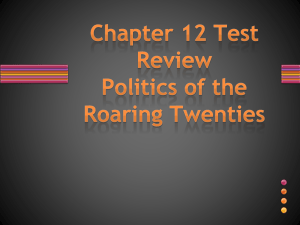Summary of the `20s
advertisement
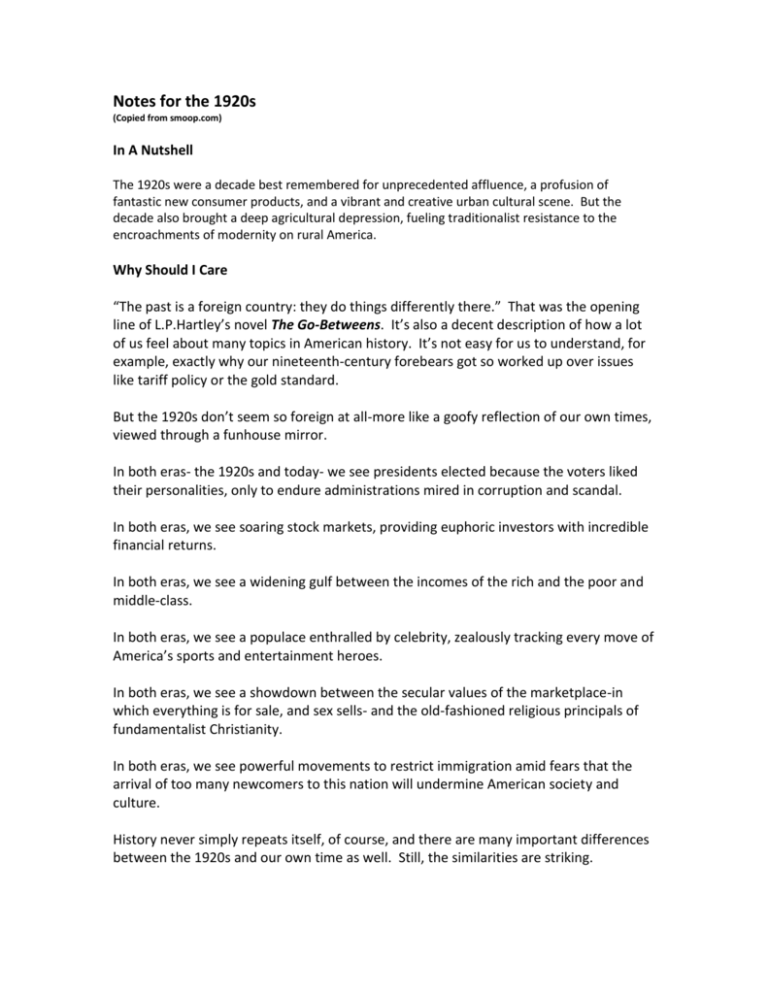
Notes for the 1920s (Copied from smoop.com) In A Nutshell The 1920s were a decade best remembered for unprecedented affluence, a profusion of fantastic new consumer products, and a vibrant and creative urban cultural scene. But the decade also brought a deep agricultural depression, fueling traditionalist resistance to the encroachments of modernity on rural America. Why Should I Care “The past is a foreign country: they do things differently there.” That was the opening line of L.P.Hartley’s novel The Go-Betweens. It’s also a decent description of how a lot of us feel about many topics in American history. It’s not easy for us to understand, for example, exactly why our nineteenth-century forebears got so worked up over issues like tariff policy or the gold standard. But the 1920s don’t seem so foreign at all-more like a goofy reflection of our own times, viewed through a funhouse mirror. In both eras- the 1920s and today- we see presidents elected because the voters liked their personalities, only to endure administrations mired in corruption and scandal. In both eras, we see soaring stock markets, providing euphoric investors with incredible financial returns. In both eras, we see a widening gulf between the incomes of the rich and the poor and middle-class. In both eras, we see a populace enthralled by celebrity, zealously tracking every move of America’s sports and entertainment heroes. In both eras, we see a showdown between the secular values of the marketplace-in which everything is for sale, and sex sells- and the old-fashioned religious principals of fundamentalist Christianity. In both eras, we see powerful movements to restrict immigration amid fears that the arrival of too many newcomers to this nation will undermine American society and culture. History never simply repeats itself, of course, and there are many important differences between the 1920s and our own time as well. Still, the similarities are striking. It is impossible for us now to look back on the 1920s without being influenced by our knowledge of how the Roaring Twenties came to an end-with a Great Crash and Great Depression. The incredible affluence was only a mirage, the decadent culture only an ironic prelude to a decade of hard times ahead. But history never simply repeats itself. Right? The 1920s Summary & Analysis The Big Picture: Who, What, When, Where & (Especially) Why The 1920s have long been remembered as the “Roaring Twenties,” an era of unprecedented affluence best remembered through the cultural artifacts generated by its new massconsumption economy: a Ford Model T in every driveway, “Amos ‘n Andy” on the radio and the first “talking” motion pictures at the cinema, baseball hero Babe Ruth in the ballpark and celebrity pilot Charles Lindergh on the front page of every newspaper. As a soaring stock market minted millionaires by the thousands, young Americans in the nation’s teeming cities rejected traditional social mores by embracing a modern urban culture of freedom-drinking illegally in speakeasies, dancing provocatively to the Charleston, listening to jazz music. The entrenched image of the 1920s as a sort of nationwide, decade-long party- a la the movable feast enjoyed by Jay Gatsby, F. Scott Fitzgerald’s fictional character who remains the iconic figure of the age- obscures a very different reality for many Americans: the “Roaring Twenties” left nearly half the country behind. The 1920 Census revealed, for the first time in United States history, a majority of Americans living in cities. Still, throughout the decade well over 40% of the country’s population resided on farms and in tiny rural communities, and down on the farm the 1920s were anything but roaring. For American farmers, the Great Depression began not with the stock market crash in 1929 but with the collapse of agricultural prices in 1920. Thus the entire decade of the 1920s was a time of poverty and crushing indebtedness, leading to ever-rising foreclosures of family farms. More than 90% of American farms lacked electricity, and the proportion of farms with access to a telephone actually DECREASED OVER THE COURSE OF THE DECADE. Furthermore, rural Americans-overwhelmingly native-born, white Protestants- found the modern, sexualized, multi-ethnic culture of the cities deeply offensive to their traditional beliefs. Their antagonism toward the perceived cultural excesses of the “roaring Twenties” fueled a political backlash that allowed a resurgent Ku Klux Klan-anti-black as always, but now also anti-immigrant, anti-Catholic, anti-Semitic, anti-evolution, anti-drinking, and anti-sex- to take over several state governments. The story of the 1920s is thus embodied no more by Henry Ford or Louis Armstrong than it is by Ed Jackson, Ku Klux Klansman, and the Governor of Indiana. The 1920s roared with a clash of civilizations as Americans struggled to reconcile the prosperous modernity of the city with the impoverished traditionalism of the country. The 1920s People Who Made It Happen Warren G. Harding Warren G. Harding (1865-1923) was the 29th President of the United States. A personable, conservative senator from Ohio, Harding won the presidential election of 1920 in a landslide by promising a "return to normalcy" after World War I. Harding's administration ended up plagued by corruption scandals, as many of the President's cronies used their high positions in government for illegal personal gain. Harding died of a heart attack less than three years into his term, before the worst revelations of corruption in his administration were revealed to the public. In retrospect, many historians rank Harding among the very worst presidents of all time. Herbert Hoover Herbert Hoover (1874-1964) was a self-made millionaire in the mining industry, a very successful Secretary of Commerce from 1921-28, and a very unsuccessful president of the U.S. from 1929 to 1933. His term saw the onset of the Great Depression, which began with the stock market crash just a few months after he took office. Today, Hoover's name is most associated with the shanty towns—"Hoovervilles"—erected during the Depression by the nation's unemployed and homeless. Hoover was elected to the presidency in 1928, promising that "we shall soon, with the help of God, be in sight of the day when poverty will be banished from this nation." Unfortunately, Hoover's presidency saw not the banishment of poverty, but instead the onset of the Great Depression, which began with the stock market crash of 1929. Andrew Melon Andrew Mellon (1855-1937) was a millionaire financier who served as Secretary of the Treasury for eleven years under Republican presidents Harding, Coolidge, and Hoover. As Treasury Secretary, Mellon pushed through a series of large tax cuts for the wealthy, freeing huge sums of capital for reinvestment in the booming stock market. During the Roaring Twenties, Mellon was regarded as a genius of rapid economic growth; after the Great Crash, however, he was blamed by many for unwisely promoting wealth inequality and an unsustainable financial bubble. Eugene Debs Eugene Debs (1855-1926), a longtime labor organizer and left-wing political activist, was the leader of the American Socialist Party and an unsuccessful candidate for president on the Socialist ticket in 1904, 1908, 1912, and 1920. During World War I, Debs was convicted of violating the draconian new Espionage Act by giving a speech criticizing the war. He was sentenced to ten years in federal prison. Despite his incarceration, Debs ran for president again in 1920 and won nearly a million votes from his jail cell. Al Smith Al Smith (1873-1944) was a four-term governor of New York and the Democratic candidate for president in 1928. Smith, a fierce opponent of Prohibition and the first Roman Catholic to win a major-party nomination for the presidency, was trounced in the 1928 election by Republican Herbert Hoover. Smith's nomination revealed the weakening split in the Democratic Party during the 1920s. His appeal to the northern, urban, ethnic, anti-Prohibition wing of the party was offset by his rejection by southern, rural, white, Protestant, Prohibitionist Democrats. Smith became the first Democrat since the Civil War to lose multiple states of the old Confederacy. Henry Ford Henry Ford (1863-1947) was one of America's greatest businessmen, the founder of Ford Motor Company and the man largely responsible for initiating the era of mass-consumption and mass-production in the American economy. Ford's innovative business practices, including standardization, the assembly line, and high wages for workers, revolutionized American industry. Ford also became one of America's most prominent citizens in the early twentieth century, and began to take strong positions on social affairs. One of the causes Ford championed was the "Americanization" and assimilation of new immigrants. Ford sponsored an Americanization School for foreign workers at his auto plants, encouraging them to conform to middle-class American lifestyle standards if they wanted to keep their jobs. D.W.Griffith D.W. Griffith (1875-1948) was an important movie director of the early twentieth century and one of the founders of the Hollywood film industry. Griffith's 1915 film Birth of a Nation—which depicted Ku Klux Klansmen as triumphant heroes—was one of the most important films in American history. A runaway box office success, it proved the viability of the Hollywood feature film as a commercial product. It also revealed the deep racism still prevalent in American society, and led to a resurgence of the Ku Klux Klan. F. Scott Fitzgerald F. Scott Fitzgerald (1896-1940) was a prominent American writer of the "Lost Generation," the author of novels including This Side of Paradise, Tender is the Night, and—most famously—The Great Gatsby. Fitzgerald achieved huge fame and success by his midtwenties, and later struggled to live up to the expectations he had created for his own work. He died of alcoholism at the age of 44. For many, the decadent world portrayed in The Great Gatsby remains the defining image of life in America during the Roaring Twenties. Margaret Sanger Margaret Sanger (1879-1966) was the nation's most important birth control advocate in the early twentieth century. At a time when basic information about sex, sexuality, and even anatomy was often outlawed as obscene, Sanger worked to educate women about the reproductive process to allow them to choose when and whether to bear children. She was convinced that society could not evolve unless people practiced family planning, especially among the poor. In 1921, Sanger founded the American Birth Control League (now known as Planned Parenthood) to advocate for birth control rights. Though she faced much criticism for her work, Sanger also spurred young women all over the country to look beyond traditional social mores. Throughout the 1920s, Sanger answered millions of letters sent by women asking questions about birth control, and also lectured on the topic throughout the country. Charles Lindbergh Charles Lindbergh (1902-1974) was an American pilot and the first man to fly solo across the Atlantic Ocean. Lindbergh's solo transatlantic flight in 1927 made him one of America's early celebrity heroes. He received a New York ticker-tape parade, and newspapers breathlessly covered his every move. Babe Ruth Babe Ruth (1895-1948) was one of the greatest baseball players of all time, a fearsome power hitter whose home run records stood for decades. Ruth's feats on the diamond (and his garrulous charisma off of it) helped to transform baseball from a game to a major force in the modern entertainment industry. Public interest in the Babe drove radio to begin broadcasting baseball games, and so many people wanted to see Ruth play that his team built itself a palatial new ballpark—Yankee Stadium, which remained home to the Bronx Bombers until 2008. Marcus Garvey Marcus Garvey (1887-1940) was the most popular black nationalist leader of the early twentieth century, and the founder of the United Negro Improvement Association (UNIA). A Jamaican immigrant, Garvey rose to prominence as a soapbox orator in Harlem, New York. By the 1920s, the charismatic Garvey's UNIA claimed more than 4 million members, and crowds of more than 25,000 people packed into Madison Square Garden to hear Garvey speak of racial redemption and repatriation to Africa. Garvey's militancy and popularity spooked the U.S. government, which eventually imprisoned and deported Garvey on dubious charges of mail fraud. Langston Hughes Langston Hughes (1902-1967) was an African-American poet, novelist, and playwright. He remains beloved especially for his poetry, and is considered one of America's greatest poets. During the 1920s, Hughes was one of the leading figures of the Harlem Renaissance, an explosion of black cultural vitality that sprang up in the African-American enclave of Harlem, New York. One of Hughes' most famous poems, "Harlem (Dream Deferred)" is a powerful statement of burgeoning black intellectualism in an age of racial oppression. Zora Neale Hurston Zora Neale Hurston (1891-1960) was an African-American writer, best known for the novel, Their Eyes Were Watching God. During the 1920s, Hurston was one of the leading figures of the Harlem Renaissance, an explosion of black cultural vitality that sprang up in the African-American enclave of Harlem, New York. Sinclair Lewis Sinclair Lewis (1885-1951) was an American novelist and playwright, and the first American to win the Nobel Prize in Literature. During the 1920s, Lewis's works Main Street and Babbitt, skewered what he saw as the mindless consumption and conformity of middle-class American society in an age of affluence. The 1920s Facts Brain Snacks: Tasty Tidbits of Knowledge Estimated peak membership in the Ku Klux Klan during the 1920s: 4 million Estimated peak membership in the Ku Klux Klan during the 1870s: 500,000 Estimated peak membership in the Ku Klux Klan during the 1960s: 20,000 Years D.W. Griffith's Ku Klux Klan-glorifying epic, Birth of a Nation, held the record for highest-grossing Hollywood picture: 22 Film that finally broke Birth of a Nation's record: Walt Disney's Snow White and the Seven Dwarfs Estimated income of bootleg liquor industry in 1929: $3 billion Entire United States federal budget in 1929: $2.9 billion18 Estimated number of speakeasies (illegal saloons) in United States during prohibition: 200,000-500,000 The 1920s Quotes They Said It "The business of America is business." - President Calvin Coolidge20 "We in America today are nearer to the final triumph over poverty than ever before in the history of any land... we shall soon, with the help of God, be in sight of the day when poverty will be banished from this nation." - Presidential candidate Herbert Hoover, 192821 "These men of many nations must be taught American ways, the English language, and the right way to live." - Henry Ford, speaking of immigrants22 "History writ with lightning, and my only regret is it's all so terribly true." - President Woodrow Wilson, commenting on the pro-KKK film Birth of a Nation23 "Scopes isn't on trial, civilization is on trial." - Defense attorney Clarence Darrow, on the Scopes "Monkey" Trial24 "They did not come here to try a case. They came here to try revealed religion. I am here to defend it, and they can ask any questions they please." - William Jennings Bryan, testifying at the Scopes "Monkey" Trial25 Statistics By the Numbers Population of United States in 1920: 105.7 million ... in 1930: 122.8 million1 Census year in which urban population surpassed rural population for the first time in American history: 1920 Percentage of American homes with electricity in 1920: 35% ... in 1929: 68% Percentage of American farms with electricity in 1920: 2% ... in 1929: 9%2 Wholesale price of wheat in 1920: $2.45 per bushel ... in 1921: $1.30 per bushel ... in 1932: 49 cents per bushel Wholesale price of cotton in 1920: 42 cents per pound ... in 1921: 10 cents per pound ... in 1932: 5 cents per pound Average per capita income for all Americans in 1929: $750 Average per capita income for American farmers in 1929: $2733 Dow Jones Industrial Average, November 1919: 119.62 Dow Jones Industrial Average, August 1921: 62.57 Dow Jones Industrial Average, September 1929: 381.17 Dow Jones Industrial Average, November 1929: 198.69 Dow Jones Industrial Average, July 1932: 41.224 Year in which Dow Jones Industrial Average first surpassed the level of its 1929 peak: 19545 Number of millionaires in America at time of stock market peak in 1929: 25,000- 35,000 Number of millionaires in America at time of stock market bottom in 1932: 5,0006 Percentage of Americans who owned stock at time of 1929 Crash: less than 1 1929 ratio of the incomes of the top 0.1 percent of Americans, to the incomes of the bottom 42 percent: 1:1 Acronyms The 411 on the AKAs... FYI ACLU: American Civil Liberties Union KKK: Ku Klux Klan UNIA: Universal Negro Improvement Association Glossary The 1920s Terms Americanization The process by which immigrants assimilate to the social and cultural customs of the United States. Financial Bubble, Stock Market Bubble, Bubble A market phenomenon in which overly optimistic traders bid up prices for assets to a level far beyond their intrinsic value. Bubbles lead to spectacular short-term profits but eventually burst, causing a rapid decline in asset values. The trouble is that it is difficult or impossible to distinguish a bubble from a normal bull market until after the bubble has burst. In retrospect, it seems clear that the booming stock market of the 1920s was a classic bubble, which burst with devastating effect in the Great Crash of 1929. Financier, Financiers A large-scale investor or major player in the stock market. Fundamentalist Christianity, Fundamentalists A branch of American Protestantism that arose in the early twentieth century in opposition to modernist cultural changes. Fundamentalists emphasize rigid adherence to traditional biblical teachings and conservative social mores, and insist upon a literalist rather than metaphorical reading of the Bible. Laissez-Faire From a French term meaning "let the people do as they please," laissez-faire is the philosophy that government should not intervene to regulate the affairs of the free market economy. Laissez-faire ideology was powerful in late nineteenth-century America, then after a period of stronger government regulation experienced a resurgence in the 1920s. Political Economy The aspect of social science or philosophy that deals with the optimal interaction between the capitalist marketplace and the democratic political system. Reconstruction Reconstruction was the government-led effort to transform Southern society following the Civil War. With the South under military occupation, Reconstruction governments sought to ensure civil rights for formerly enslaved blacks. The North abandoned Reconstruction after 1876, allowing southern whites to regain power and reimpose a social system based on white supremacy. The historical time period after the Civil War and before the withdrawal of federal troops from the South. Reconstruction is usually dated from 1865-1877, but it technically ended earlier in several southern states where conservative white "Redemptionist" rule took hold after the state had already been readmitted to the union and whites had organized to prevent blacks from voting or exercising their other newfound rights. During Reconstruction, the government passed a series of laws establishing the criteria by which the former Confederacy could reenter the Union. When the Congressional (or "Radical") phase of Reconstruction commenced in 1867, the criteria became more stringent and states had to accept several new federal requirements for readmission. The Radical Republican Congress sought to safeguard the rights and liberties of African-Americans, and for a time, it succeeded at least in part. Black men held public office at the local, state, and federal levels. Black communities established their own churches, schools, and associations. The South as a whole received some of its first public hospitals and public schools. Reconstruction did not last longer than a decade in most places, but it was a critically important time that would be remembered for generations by blacks and whites alike (though usually in very different ways). Regulators Public officials charged with enforcing laws designed to regulate the conduct of private businesses. During the Progressive Era, Congress passed a wide variety of new regulations on economic activity; during the 1920s, many of the officials appointed to enforce those regulations were philosophically opposed to government regulation of business and therefore chose to enforce the laws quite loosely. Reparations, Reparation Reparations are payments made by a defeated nation in war to compensate its conqueror for costs incurred in the conflict. When Germany surrendered to end World War I, the Allies demanded that Germany pay them heavy reparations as a condition of peace. The high cost of reparations ruined Germany's economy, leading to economic collapse and the rise of Adolf Hitler. Repatriation, Repatriated, Repatriate The return of an immigrant to his country of origin. Many of the so-called New Immigrants of the late nineteenth and early twentieth centuries did not settle permanently in the United States, but rather stayed long enough to earn a significant quantity of money then repatriated to their homelands. Retrenchment, Retrenchments Cutting back on expenses during times of economic difficulty. A business pursuing retrenchment would cut production and lay off employees; an individual pursuing retrenchment would cut back on consumer spending. Speakeasies, Speakeasy Illegal, underground saloons that operated during the Prohibition era when sale and consumption of alcohol was illegal in the United States. Traditionalist, Traditionalists A person who holds traditional, conservative views and opposes radical social and cultural changes. Copied from shmoop.com PEOPLE Warren G. Harding Conservative Republican president, elected 1920 Likable personality but plagued by corruption scandals Died in office, 1923 Calvin Coolidge Conservative Republican president Elected vice president, 1920 Became president at Harding's death, 1923 "The business of America is business" Reelected, 1924 Popular; oversaw "Coolidge prosperity" Herbert Hoover Progressive Republican president Self-made millionaire in mining industry Successful Secretary of Commerce, 1921-28 "We in America today are nearer to the final triumph over poverty than ever before in the history of any land," 1928 Elected president in landslide, 1928 Presidency ruined by Great Depression, 1929 Al Smith Four-term Governor of New York Wanted to end Prohibition Democratic Party candidate for president, 1928 First Roman Catholic nominee for president Crushed by Hoover in 1928 election Eugene Debs Labor leader and head of Socialist Party Arrested under Espionage Act for criticizing President Wilson's conduct of World War I, 1918 Ran for president from federal prison in 1920 Won nearly 1 million votes in 1920 election Margaret Sanger Leading birth-control advocate Founded American Birth Control League (now known as Planned Parenthood) Andrew Mellon Wealthy Wall Street investor Secretary of the Treasury under Harding and Coolidge Pro-business policies led to economic boom of Roaring Twenties, but also to bust of 1929 Great Crash Henry Ford Famous automaker Developer of Model T, first popular car Pioneered assembly-line process of mass production in industry Wanted Americanization of foreign-born workers; had anti-immigrant and anti-Semitic beliefs Charles Lindbergh Famous pilot First person to fly an airplane solo across the Atlantic Became one of America's first hugely popular celebrities Marcus Garvey Black nationalist leader Advocated black pride and resettlement of American blacks back to Africa "Africa for Africans, at home and abroad" Founded Black Star Line steamship company Convicted of mail fraud under dubious circumstances and deported to Jamaica Al Capone Infamous Chicago gangster Made millions selling illegal liquor during Prohibition Convicted of income tax evasion and jailed at Alcatraz, 1931 D.W. Griffith Hollywood filmmaker Directed Birth of a Nation, the first real box-office blockbuster, 1915 Birth of a Nation glorified the Ku Klux Klan Copied from shmoop.com EVENTS 1915 Birth of a Nation First Hollywood blockbuster film Set box-office sales record that lasted 22 years Film glorified the Ku Klux Klan, leading to KKK revival in 1920s 1919 Red Scare Post-World War I crackdown against radicals Fueled by fear of Communist revolution Increased powers of Federal Bureau of Investigation Crushed American radical and labor groups 1919 18th Amendment Enacted Prohibition Banned sale or manufacture of alcohol in United States Repealed in 1933 1920 19th Amendment Achieved woman's suffrage Granted women the right to vote 1920 Presidential Election Republican Warren G. Harding elected president Democrat James Cox crushed Harding promised "return to normalcy" 1923 Death of President Harding Harding died of heart attack in San Francisco, 1923 Death ended scandal-plagued administration Vice President Calvin Coolidge became president 1924 Presidential Election Popular Republican President Coolidge elected to his own full term Democrat John W. Davis crushed 1924 National Origins Act Restricted immigration Expanded upon earlier immigration restrictions passed in 1921 Created immigration quotas based on nation of origin Discriminated against immigrants from Southern and Eastern Europe 1925 Scopes Monkey Trial Tested Tennessee law banning teaching of evolution Celebrity attorneys (Clarence Darrow and William Jennings Bryan) represented both sides Teacher John Scopes convicted Trial was a publicity stunt 1928 Presidential Election Republican Herbert Hoover elected president Hoover promised "triumph over poverty" Hoover won more electoral votes than any previous presidential candidate Democrat Al Smith became the first Catholic to run for president, but was crushed in election 1929 Stock Market Crash Financial panic struck Wall Street, causing collapse in prices of stocks Stock market lost nearly 90% of its value between 1929 and 1932 Signaled onset of Great Depression GROUPS Ku Klux Klan Reached height of popularity in 1920s Revival followed positive portrayal of Klan in 1915 film Birth of a Nation Anti-black, anti-Catholic, anti-Semitic, anti-immigrant, anti-sex, anti-alcohol Controlled several state governments in 1920s "New Immigrants" Immigrants from Southern and Eastern Europe 25 million immigrants entered United States, 1880-1920 Different national and ethnic background of "new immigrants" alarmed many native-born citizens "New immigration" cut off by restrictive 1924 National Origins Act Harlem Renaissance Literary and cultural movement of African Americans concentrated in New York's Harlem neighborhood Langston Hughes, Zora Neale Hurston, Claude McKay important figures in Harlem Renaissance Lost Generation American writers living in Europe (especially Paris) after World War I F. Scott Fitzgerald, Ernest Hemingway, Gertrude Stein important figures in Lost Generation American Birth Control League Founded by Margaret Sanger to advocate for legalization of birth control Now known as Planned Parenthood CONCEPTS Americanization Process by which immigrants were made into Americans Pushed heavily by Henry Ford and others who wanted to strip immigrants of ethnic identity "New" Immigrants Immigrants from Southern and Eastern Europe, including Russians, Poles, Jews, Italians Arrived in large numbers between 1880 and 1920 Initially considered by many Americans to be inferior to "old" immigrants from Nothern and Western Europe PLACES Dayton, Tennessee Small rural town hosted famous "Scopes Monkey Trial" in 1925, testing the legality of the teaching of evolution in public schools Entire trial deliberately organized as a publicity stunt to gain attention for the economically struggling town Harlem, New York African American neighborhood at northern end of Manhattan in New York City Site of vibrant black cultural movement known as "Harlem Renaissance" during 1920s Home of Marcus Garvey's black nationalist movement
